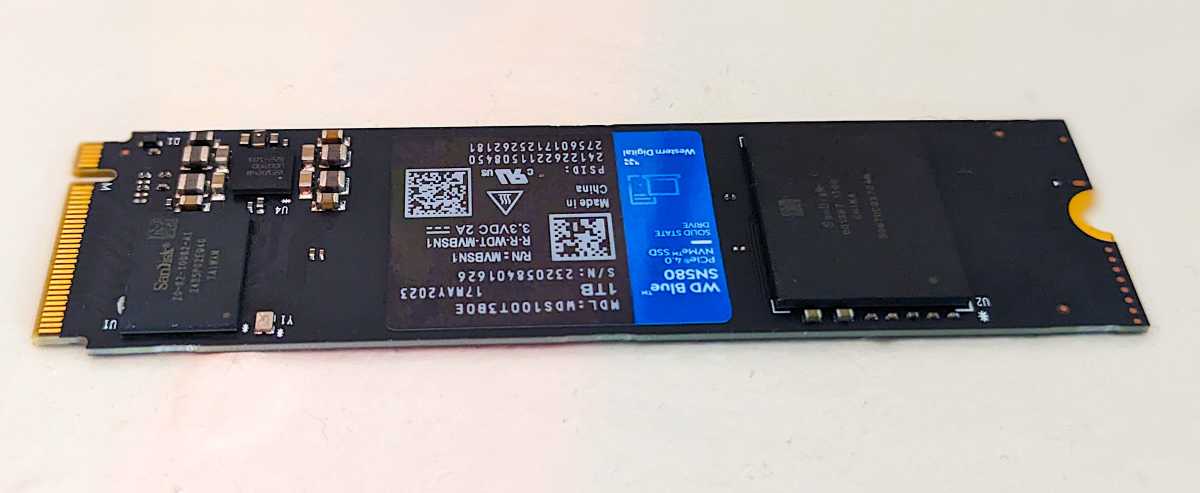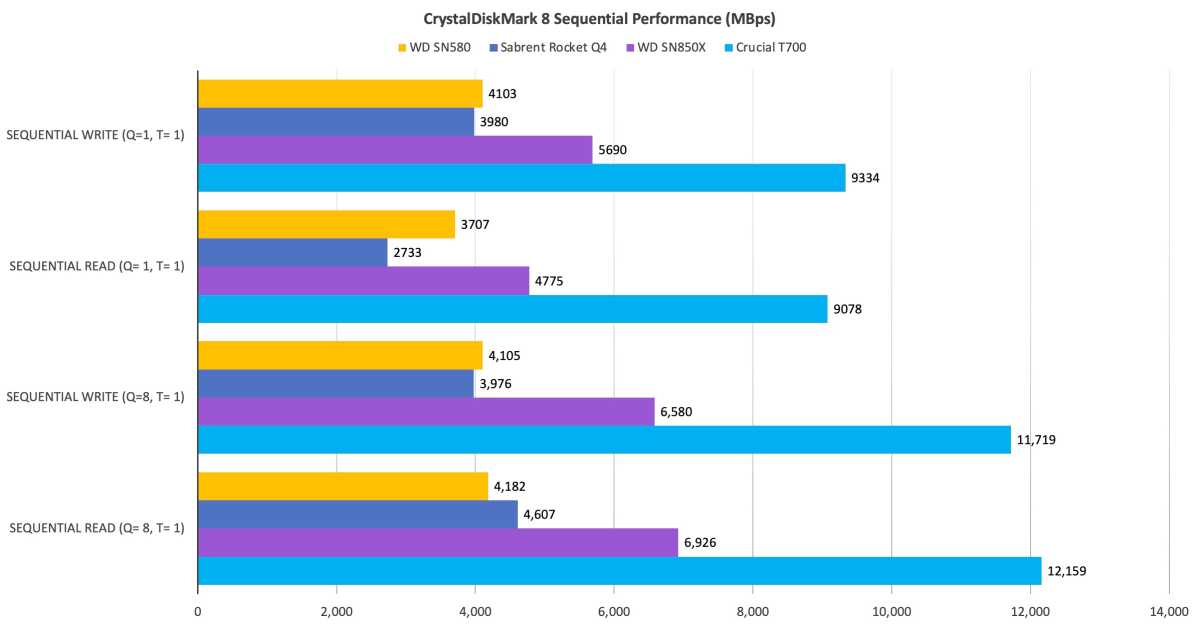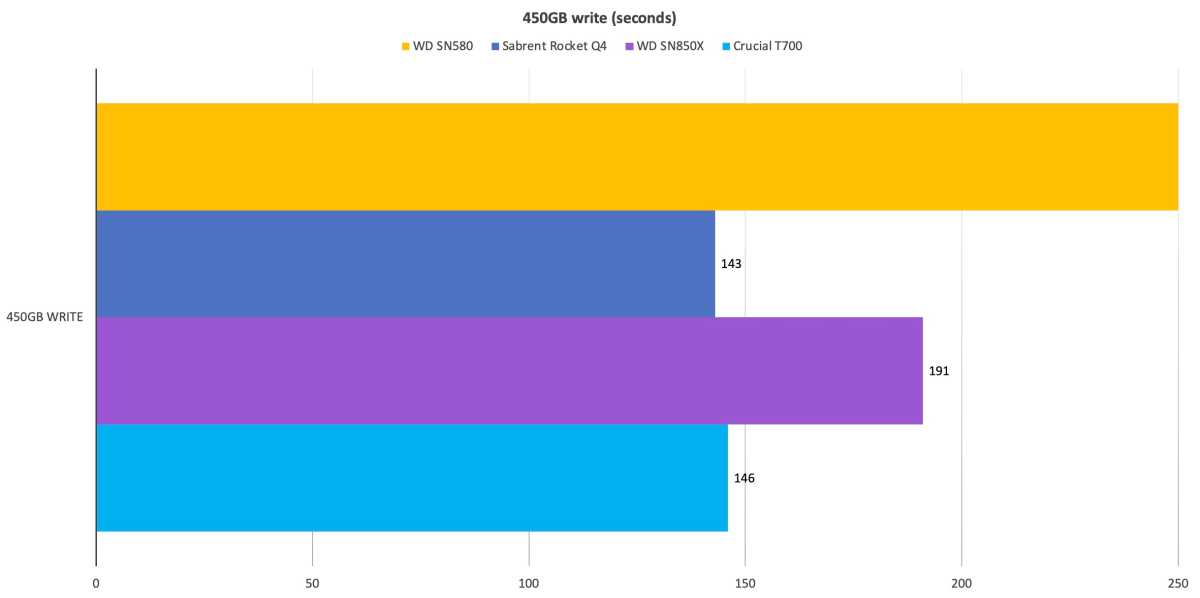Expert’s Rating
Pros
- Fantastically affordable
- Super fast real world transfers
- Single-sided for laptop upgrades
Cons
- Slows to less than 300MBps when writing off secondary cache
- Slightly low endurance rating
Our Verdict
We came darn close to awarding this fantastically affordable, yet super fast NVMe SSD five stars. It’s the bargain on the market at the moment, and there’s not another drive that comes close.
Wow, it took a while, but thanks to WD, NVMe SSDs have finally become commodity items. Case in point: the company’s Blue SN580, which delivers 1TB of capacity for a ridiculously affordable $50. It’s also extremely fast in real-world tasks. Fast? Super inexpensive? We’re guessing other SSD vendors aren’t going to be happy.
SN580 design, specs, and pricing
Physically, the WD SN580 is your standard, single-sided 2280 (22 mm wide, 80 mm long) SSD. It’s appropriate for laptop upgrades, it’s PCIe 4.0 x4, and uses a WD/Sandisk-branded controller and Sandisk-labeled 112-layer TLC (Triple-Level Cell/3-bit) NAND.
Once again, it’s by far the least expensive NVMe SSD we seen, available in $28/250GB, $32/500GB, $50/1TB, and $110/2TB capacities (we tested the 1TB drive). These sticker prices approach half the costs of the competition in the 1TB and 2TB flavors.
Can you say “game-changing” five times fast? Or perhaps, “There go the margins” if you’re a competing SSD vendor.

Of course, something’s got to give with prices this low, but the compromise isn’t that bad. The SN580 is warrantied for five years/or 450TBW (TeraBytes that may be Written) per 1TB of capacity. 600TBW is the bargain norm, but considering the unprecedented bang-for-buck of this drive, you shouldn’t care. An endurance rating of 450TBW means you can write (that is, copy or save) an average of 246GB per day to the drive for five years.
WD plays up something called nCache 4.0, which, as this is a host memory buffer design, likely has to do with interfacing your device’s memory (the host bus memory) that the drive uses for primary caching. As our recent test of the Sabrent Rocket Q4 revealed a substantial uptick in HMB performance from the previous generations, I’m assuming nCache is at least somewhat related.
Despite the pricing, WD bundles its SSD Dashboard to monitor the drive as well as Acronis True Image for backup. It’s quite the package deal.
SN580 performance
The SN580 is the second PCIe 4.0 NVMe SSD we’ve tested that uses host bus memory. Like the recently reviewed Sabrent Rocket Q4, the SN580 turned in some stellar benchmark and real world results. In fact, the SN580 bested the Sabrent in many of our tests.
Indeed, the SN580’s times in transferring our 48GB small file and folder data set are bizarrely fast. It beat the former number one PCIe 5.0 Crucial T700 by 23 seconds. Holy smokes!
Not quite believing our eyes, we took a number of extra passes at this test, and as far as we can tell, there was no monkey business going on. Apparently, SanDisk (WD’s SSD guru) has conjured up some form of advanced transfer magic.

Industry scuttlebutt has it that the latest Micron NAND is simply stellar when writing in SLC mode. This NAND may be labeled Sandisk/China, but I’m guessing it is, at the very least, a similar design that leverages the same breakthrough.
If you’re not familiar, SLC means a one-bit/single level cell/or write where any voltage is a one, and no voltage is zero. MLC, TLC and QLC use multiple voltage levels to represent larger numbers, but the error checking to assure the correct level is indeed written slows things down quite a bit. Running in SLC mode means the drive can go much faster.
Below you can see the SN580’s CrystalDiskMark 8 numbers. The first three drives are PCIe 4.0, with the Crucial T700 being PCIe 5.0. The SN850X and T700 have DRAM cache, while, as stated, the SN580 and Rocket Q4 use host bus memory. As you can see, when it comes to NVMe and synthetic benchmarks, PCIe 5.0 rules.

Our test sample of the SN580, having only 1TB of capacity, did stall out during the 450GB write, turning in the slowest time we’ve seen on our new test bed. It’s unlikely you’ll write 450GB of contiguous data very often, but the slowdown is indicative of the performance you’ll get when the drive is filled close to capacity. (For that reason, it’s a good idea to buy an SSD with more capacity than you think you’ll need.)
As you’ll see below, the seconds piled up only toward the end when the write slowed to 500MBps. However, that is around 200MBps faster than we’ve previously seen TLC written natively. Something has truly improved in NAND tech.

To be completely fair, the other 1TB SSD we’ve written our 450GB file to recently, the Adata Legend 960, was only two seconds faster. In its 2TB incarnation, the SN580 would turn in a much more competitive time.

Where the SN580 impressed the most was obviously in our 48GB transfers, regularly topping 3GBps, a speed formerly reached only by PCIe 5.0 SSDs.
Yup, our last two HBM SSDs were as dominant over PCIe 4.0 as PCIe 5.0 SSDs are over 5th gen. Of course, we haven’t tested any HBM PCIe 5.0 drives yet, so that’s not the full picture. It will likely be a while before bargain PCIe 5.0 drives are available, but keep an eye out.
By Grapthar’s hammer, what a savings!
If you get the reference, nice to know you. If not, that’s simply a nerdy way of saying that the SN580 is a wonderfully high-performing NVMe SSD that costs a whole lot less than the competition. As long as that situation holds, the SN580 is the SDD you want at this price point.
How we test SSDs
Internal drive tests currently utilize Windows 11, 64-bit running on an X790 (PCIe 4.0/5.0) motherboard/i5-12400 CPU combo with two Kingston Fury 32GB DDR5 4800MHz modules (64GB of memory total). Both 20Gbps USB and Thunderbolt 4 are integrated to the back panel and Intel CPU/GPU graphics are used. The 48GB transfer tests utilize an ImDisk RAM disk taking up 58GB of the 64GB of total memory. The 450GB file is transferred from a Samsung 990 Pro 2TB which also runs the OS.
Each test is performed on a newly formatted and TRIM’d drive so the results are optimal. Note that in normal use, as a drive fills up, performance will decrease due to less NAND for secondary caching, as well as other factors.
Caveat: The performance numbers shown apply only to the drive we were shipped and to the capacity tested. SSD performance can and will vary by capacity due to more or fewer chips to shotgun reads/writes across and the amount of NAND available for secondary caching. Vendors also occasionally swap components. If you ever notice a large discrepancy between the performance you experience and that which we report, by all means, let us know.
For all the latest Technology News Click Here
For the latest news and updates, follow us on Google News.
